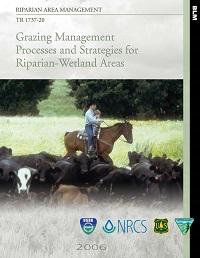Grazing Management Processes and Strategies for Riparian-Wetland Areas

BLM Technical Reference 1737-20
The case studies throughout this technical reference illustrate successful livestock grazing strategies and the consequent maintenance or recovery of riparian area function. These are just a few examples of riparian area improvement through livestock grazing that have occurred in the past 20-30 years on private and public land throughout the West. The compatibility of grazing in riparian areas depends on the extent to which the selected grazing management strategy considers and adapts to certain basic ecological and economic relationships. Prior to developing grazing management strategies for riparian areas, managers should have some understanding of grazing effects on the following:
- Functions of riparian ecosystems
- Growth and reproduction of woody and herbaceous plants on the site
- Dependency of other animals (mammals, fish, birds, and amphibians) on riparian areas
- Hydrologic and geomorphic conditions and processes
- Soils
- Water quality and quantity
- Recovery rates
- Upland conditions
- Other uses and demands for the site (e.g., recreation, domestic water)
An ecosystem perspective is critical to successful riparian area management. Leonard et al. (1997) stated that the structure and processes of riparian areas, more than those of any other ecosystem, are influenced by their connectivity to adjacent upland ecosystems. An ecosystem or watershed perspective provides a comprehensive basis for evaluating current grazing practices and other land uses, identifying riparian management objectives, and developing future management alternatives.
Analyzing trends from an adaptive management perspective will help determine if goals and objectives are being met and what changes may be needed to move toward the desired outcome. The information presented in this document will further enhance the ability of livestock managers to develop and implement successful riparian area grazing strategies. More information is available from other sources such as the Web sites listed in Appendix A.
